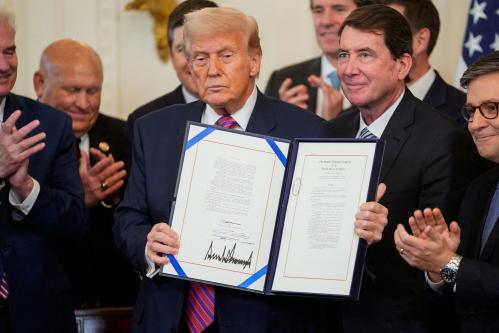This piece was published in May 2025, before passage of the GENIUS Act. For more recent commentary by Nellie Liang, read this piece.
Stablecoins continue to grow, and use cases are increasing. The vast majority are tied to the U.S. dollar, but the U.S. lacks a strong, consistent, and coherent regulatory framework. I describe below some essential features of a regulatory framework for the U.S. that would both support financial innovation and reduce serious risks, many of which were highlighted in a report on stablecoins in 2021 by the President’s Working Group. Current financial regulations, mainly a diverse set of state money transmitter licensing requirements, are inadequate for significant stablecoins that operate across state and national borders, raise new and unique illicit finance risks, and threaten monetary and financial stability.
Stablecoins function as “digital cash” issued by a private firm that is recorded and transferred on a blockchain rather than on the books and records of a commercial bank or central bank. The market value of stablecoins has grown from less than $20 billion in 2019 to more than $230 billion on a global basis in early 2025. Stablecoins currently are used mainly for trading crypto assets, although there is growing use of USD-based stablecoins in countries with less stable domestic currencies. Evidence points to increased use for terrorist financing and money laundering.
Stablecoins offer potential to increase competition and efficiency of payments and capital markets activities as well as to support the global role of the dollar and U.S. national security. Stablecoins could make payments more efficient and available in real time as consumers increasingly demand faster, cheaper payments and businesses aim for efficiencies. For instance, blockchain rails could increase efficiency and innovation in cross-border payments and corporate treasury management as well as in merchant payments. The upside is greater if tokenization of securities becomes more widespread, since stablecoins would be a natural means of payment for securities transactions that are executed on-chain.
But stablecoins come with risks. From a financial stability perspective, they could be subject to runs if their value is not truly stable, and they could undermine the safety of payments if their operations are not robust to a range of operational and cyber threats. And their potential to scale rapidly because of network effects could increase risks to credit intermediation and monetary policy transmission if insured depository institutions lose significant deposits to stablecoins, or could lead to excessive concentration of power if stablecoins are issued by commercial firms.1 In addition, stablecoins present new and significant illicit financing risks since values can be transferred quickly across borders if actors are able to exploit weaknesses in international anti-money laundering and countering the financing of terrorism (AML/CFT) standards.
To address the risks that stablecoins pose, a regulatory framework should include seven essential features:
- Reserve assets of a stablecoin issuer need to be ultra-safe and liquid if stablecoins are to function as money issued by a private firm. Because stablecoins do not have deposit insurance or access to a lender of last resort, they need to be backed by safe and liquid assets, like cash, Treasury bills, and central bank reserves, so they can offer convertibility at par. If assets with either credit or counterparty risk were to be permitted, the stablecoin issuer should be required to hold more capital and liquidity for those risks. Private money backed by risky assets with inadequate capital would be vulnerable to destabilizing runs and lose its ability to function as a medium of exchange.
- Stablecoin issuers’ activities should be limited to issuance and redemption (and ancillary activities), and issuers that achieve significant size should be subject to prudential federal regulations for capital, liquidity, and risk management calibrated to its limited activities. An issuer also should be subject to strong operational standards to ensure payment finality and reliability and its resilience to crypto, cyber, and other threats. In addition, stablecoin issuers should be subject to consumer protection rules that apply to similar payment products and services. At a minimum, the qualifications and integrity of an applicant should be considered when financial regulators consider granting a charter, either for a nonbank or a subsidiary of a depository institution.
- Reserve assets of a stablecoin should be segregated and prioritized in bankruptcy, so that holders can still access their payment stablecoins if a stablecoin issuer were to fail. Clear rights to immediate redemption are needed for stablecoins of a failing issuer to prevent payment disruptions even as the issuer’s liabilities are settled in bankruptcy over a longer period.
- Stablecoin issuers should be subject to AML/CFT rules and strict enforcement. Efforts to effectively implement these standards on a worldwide basis and close gaps should be accelerated. While blockchain technology allows issuance and transactions without connecting to a regulated financial intermediary—the primary connection to these requirements—technologies are advancing to analyze blockchain transactions and identify bad actors. While more development is needed (and full identification may not be achievable, as is the case when paper cash is exchanged), issuers should be expected to proactively use these technologies to block and freeze accounts that are associated with illicit financial transactions. Additional rules may be needed on entities other than issuers to effectively counter money laundering and terrorism financing.
- Stablecoin issuers should be subject to affiliate restrictions to prevent the buildup of concentrated economic power. Affiliation of a stablecoin issuer with a commercial firm, such as a big tech firm, could lead to excessive concentration of economic power through advantages in using existing commercial data or by raising the costs of switching from a stablecoin in a “walled garden” to other payment products. For banking, these types of concerns have been significant enough that the U.S. has long maintained a structural separation of banking firms from commercial firms. Other solutions might also be possible, such as prohibiting anti-competitive behaviors across affiliates that would limit the free flow of money and commerce across platforms, preventing bundling of products, and providing standards for technical interoperability so that users do not face high barriers to switch among stablecoins or other payment products.
- Stablecoin issuers should not pay interest on stablecoins. Allowing for interest payments could lead issuers to compete on offered yield rather than on payment innovations. It also could draw funds away from bank deposits that underpin lending to households and businesses and are a key transmission channel for monetary policy.
- Finally, evidence indicates that stablecoins used in the majority of global transactions would not be in compliance with this basic set of proposed rules necessary for a sound U.S. framework. Steps are needed to restrict the access of U.S. persons to payment stablecoins issued abroad that do not comply with these rules. Users generally do not interact directly with an issuer but obtain their stablecoins in other ways, on trading platforms or at kiosks, so actions should consider ways to limit and enforce not only direct access but other means of access.
As with any new technology and product, stablecoins’ long-term success is not guaranteed. Even with rules that increase trust in stability and support innovation, the current state of permissionless blockchains may be too costly and unsecure for stablecoins to function practically as money. Or other products, such as tokenized bank deposits or new fast payments, may be sufficient to meet the needs of most consumers. Still, new use cases for stablecoins continue to be proposed and volumes are increasing, and safeguards to protect financial stability and prevent illicit finance are needed. At a minimum, the safeguards should include these essential elements.
-
Footnotes
- When Facebook first proposed Libra in 2019, it was believed that “the monetary sovereignty of states [was] at stake” (French Minister of Finance Bruno Le Maire).
The Brookings Institution is committed to quality, independence, and impact.
We are supported by a diverse array of funders. In line with our values and policies, each Brookings publication represents the sole views of its author(s).






Commentary
Essential features for a safe and trusted payment stablecoin
May 8, 2025